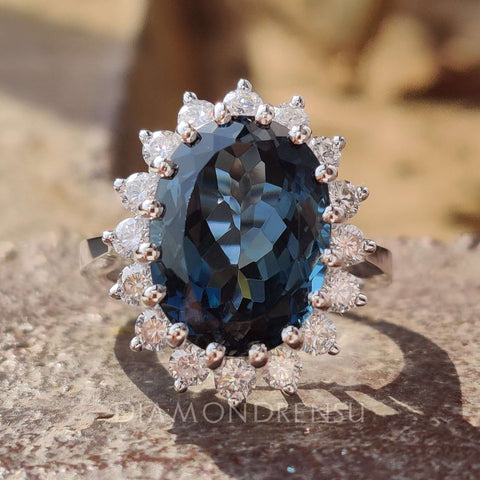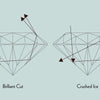
Are Lab Grown Diamonds Tacky? Debunking Common Misconceptions
Lab-grown diamonds have been gaining popularity over the past few years, providing consumers with an alternative to traditionally mined diamonds. As technology advances, man-made diamonds are becoming increasingly indistinguishable from their natural counterparts, both aesthetically and in terms of quality. Many people wonder if opting for these lab-created diamonds might be perceived as tacky or less valuable than natural diamonds.
In this article, we will dive into the world of lab-grown diamonds and explore the factors that come into play when considering their appeal. We will discuss their origins, how they are created, and how they compare to natural diamonds. Additionally, we will address whether lab-grown diamonds can truly rival the prestige and allure of their traditionally mined counterparts.
Throughout our exploration, we will strive to maintain a confident, knowledgeable, neutral, and clear tone while providing an engaging and informative discussion on lab-grown diamonds. By offering a comprehensive understanding of the topic, we hope to empower you, our readers, to make informed decisions regarding your own preferences and values when considering these dazzling stones.
What Are Lab-Grown Diamonds?
Lab-grown diamonds, or lab-created diamonds, are man-made diamonds that have the same physical, chemical, and optical properties as natural diamonds. The growth process of these diamonds involves replicating the natural conditions in which diamonds form under the Earth's surface. There are two primary methods of creating lab-grown diamonds: Chemical Vapor Deposition (CVD) and High-Pressure, High Temperature (HPHT).
Chemical Vapor Deposition (CVD) Method

The CVD method involves placing a small diamond seed in a vacuum chamber, which is then filled with carbon-containing gas. The gas is heated to extremely high temperatures, breaking down the molecules and releasing the carbon atoms. These carbon atoms then settle onto the diamond seed, gradually building up its growth structure.
The CVD process creates gem-quality diamonds with a highly controlled growth environment. The result is diamonds with fewer inclusions and a more consistent internal structure than those grown through the HPHT method. The CVD method is ideal for creating lab-grown diamond earrings, wedding bands, and engagement rings, as it produces the most desirable visual characteristics in the final product.
High-Pressure, High Temperature (HPHT) Method

The HPHT method, on the other hand, involves replicating the high-pressure, high-temperature conditions found deep within the Earth's mantle. In this process, a diamond seed is placed in a growth chamber alongside a carbon source, typically graphite or diamond powder. The chamber is then subjected to extreme heat and pressure, causing the carbon atoms to bond with the diamond seed.
This high-pressure and high-temperature environment allows the carbon atoms to transform into the crystalline structure characteristic of a diamond. As the diamond seed grows and takes on the characteristics of the surrounding carbon, lab-grown diamond bridal sets and other diamond jewelry can be crafted.
Both the CVD and HPHT methods produce lab-grown diamonds with similar properties to natural diamonds. Each method has its own advantages and disadvantages, but ultimately, both produce beautiful, eco-friendly, and high-quality diamonds that are becoming increasingly popular in the world of fine jewelry. With lab-grown diamonds, we can enjoy the beauty and brilliance of diamonds without the ethical concerns and environmental impact associated with mined diamonds.
Comparison Between Lab-Grown and Natural Diamonds
Origin and Growth Method
Both lab-grown and natural diamonds have their unique origins. Natural diamonds form in the Earth's mantle over billions of years under extreme heat and pressure. They are then brought to the surface through volcanic eruptions. On the other hand, lab-grown diamonds are created by scientists using advanced technologies. There are two primary methods for growing diamonds in a laboratory: High Pressure High Temperature (HPHT) and Chemical Vapor Deposition (CVD). Both of these methods produce diamonds that are virtually identical to those found in nature, but in a controlled environment and much faster time frame.
Physical and Chemical Composition
When it comes to the physical and chemical composition, lab-grown diamonds are remarkably similar to their natural counterparts. Both types of diamonds are made of carbon and have the same crystal structure. The difference lies in the growth process, which can cause some variations in color, clarity, and other visual aspects. For example, Rose Cut Loose Lab Grown Diamonds showcase a unique antique appearance, but still maintain the same chemical makeup as natural diamonds.
| Aspect | Lab-Grown Diamonds | Natural Diamonds |
|---|---|---|
| Origin | Created in a laboratory | Formed naturally in the earth's mantle |
| Cost | Often more affordable | Can be more expensive |
| Quality | Can have fewer imperfections | Naturally occurring inclusions |
| Ethical Considerations | Conflict-free, environmentally friendly | Mined diamonds may have ethical concerns |
| Certification | Graded by gemological laboratories | Also graded by gemological laboratories |
Clarity and Inclusions
Inclusions are tiny imperfections within a diamond, which can be a result of the diamond's growth process or external factors. Lab-grown diamonds can have inclusions too, but they tend to be more consistent and predictable. Due to the controlled environment and growth process, lab-grown diamonds often have fewer inclusions and better clarity than natural diamonds. However, both types of diamonds can still exhibit a range of clarity grades, from flawless to heavily included.
Value and Investment Potential
One of the most discussed aspects when comparing lab-grown and natural diamonds is their value and investment potential. Lab-grown diamonds are generally less expensive than natural diamonds, mainly due to lower production costs and a more consistent supply. This makes lab-grown diamonds an attractive option for consumers seeking an affordable alternative to natural diamonds, without compromising on quality. However, the investment potential for lab-grown diamonds is still uncertain, as they have not yet established the long-standing history and reputation of natural diamonds in the market. Regardless, both options offer their own unique value propositions and can be appreciated for their beauty, rarity, and symbolic significance.
Also Read
Aesthetic Appeal and Styling With Lab Grown Diamonds
Color
When it comes to lab grown diamonds, their color options can be quite appealing. They are available in a variety of shades, including yellow and blue, which provide a unique and stunning appearance. We believe that these vibrant colors can enhance the aesthetic appeal of any piece of jewelry, making them anything but tacky.
Size
Lab grown diamonds can be produced in a wide range of sizes, providing endless possibilities for creating stunning pieces of jewelry. Their availability in various carat weights ensures that there is a perfect size for every individual preference and budget. In this aspect, lab grown diamonds offer the same versatility and style options as their natural counterparts, without sacrificing beauty or quality.
Cut
The cut of a diamond has a significant impact on its overall aesthetic appeal, and lab grown diamonds are no exception. With a variety of cuts available, including the unique Rose Cut, these diamonds can be chosen to suit any desired style. A well-executed cut enhances the brilliance, fire, and scintillation of the diamond, making it a stunning focal point in any piece of jewelry.
Engagement Rings and Jewelry
Lab grown diamonds are not just limited to engagement rings but can also be found in various forms of fine jewelry. Their affordability, versatility, and eco-friendliness make them an attractive option for those looking to make a statement with their style choices. Whether it's a classic solitaire engagement ring or a contemporary and colorful piece of jewelry, lab grown diamonds offer the aesthetic appeal and quality that many people seek.
In conclusion, the aesthetic appeal and styling options for lab grown diamonds are vast and far from being tacky. With a range of colors, sizes, and cuts to choose from, we are confident that lab grown diamonds can create stunning pieces of jewelry that suit any personal style and preference.
Ethical and Environmental Considerations
Sustainability
We believe that lab-grown diamonds offer a sustainable alternative to natural diamonds. The process of creating these diamonds requires significantly less land, water, and energy resources than traditional mining operations. Additionally, lab-grown diamonds can be produced using renewable energy, contributing to a lower carbon footprint. It's important to consider the environmental impact when making a choice between lab-grown and natural diamonds.
Conflict-free Diamonds
One of the most significant ethical advantages of lab-grown diamonds is that they are conflict-free. The term "blood diamonds" refers to natural diamonds that are mined in conflict zones and sold to fund armed violence against governments. By choosing to purchase lab-grown diamonds, we can ensure that our purchases do not inadvertently support illegal or unethical practices. This means we can wear our diamonds with confidence, knowing that they were created without harming others or contributing to conflicts.
Environmentally-Friendly Production
Lab-grown diamonds are created using controlled processes which have minimal impact on the environment. Unlike natural diamond mining, which can result in habitat destruction, soil erosion, and water pollution, the production of lab-grown diamonds takes place in a clean, controlled environment. Additionally, innovations in the lab-grown diamond industry are continually improving the efficiency and environmental friendliness of the process. As a result, we can appreciate the beauty of our lab-grown diamonds while knowing that their creation aligns with our ecological values.
In conclusion, lab-grown diamonds offer ethical and environmental benefits that make them an attractive choice for those looking to make a responsible gemstone purchase. By opting for lab-grown diamonds, we can support sustainable, conflict-free, and environmentally-friendly processes in the jewelry industry.
Identifying Lab-Grown Diamonds

Diamond Testing
As we explore the lab-grown diamond industry, it's essential to understand how to identify these diamonds. One popular method for detecting lab-grown diamonds is using a diamond tester. A diamond tester is a handheld device that measures a gemstone's thermal conductivity, determining if it is a natural or lab-grown diamond. While diamond testers are useful, they may not always provide accurate results for all lab-grown diamonds, as newer generations of lab-created diamonds have similar properties to mined diamonds.
Gemological Laboratories and Certification

To ensure a more accurate identification, we can turn to gemological laboratories such as the GIA (Gemological Institute of America) and IGI (International Gemological Institute). These institutions offer professional diamond testing and certification services to authenticate the origin of the diamonds. By examining the diamonds' composition and unique characteristics, they can determine if a diamond is lab-grown or natural.
When a gemological laboratory examines a diamond, they analyze various factors such as the diamond's growth pattern, inclusions, and other properties that can provide clues about its origin. For instance, certain lab-grown diamonds exhibit unique growth patterns, which can be observed under a microscope.
After the examination, these labs provide a diamond grading report or certificate that includes crucial information such as the diamond's origin, weight, carat size, color grade, and more. This certification serves as proof of the diamond's origin and can be essential when buying or selling a diamond.
In summary, understanding how to identify lab-grown diamonds is crucial in the diamond industry. By using diamond testers and seeking certification from reputable gemological laboratories like GIA and IGI, we can accurately distinguish between natural and lab-grown diamonds, allowing informed choices when purchasing or selling these precious gems.
Frequently Asked Questions
Do lab-grown diamonds hold their value?
We understand that one of the primary concerns with lab-grown diamonds is their value retention. While it is true that lab-grown diamonds may not hold their value as well as natural diamonds, they still offer an affordable and ethical alternative to traditionally mined diamonds. Plus, they are of the same quality and beauty as natural diamonds.
Are lab-grown diamonds real?
Yes, lab-grown diamonds are indeed real diamonds. They have the same chemical composition, crystal structure, and physical properties as natural diamonds. The main difference is their origin. Lab-grown diamonds are created in a controlled environment using advanced technology, whereas natural diamonds are formed deep within the Earth's mantle over billions of years.
Are lab-grown diamonds worth it?
The worth of lab-grown diamonds largely depends on your personal preferences and values. They are generally more affordable than natural diamonds and offer a more environmentally friendly and ethical option. If you prioritize these factors and appreciate the identical appearance and quality to natural diamonds, then lab-grown diamonds may be a perfect choice for you.
Do people care if a diamond is lab-grown?
People's opinions about lab-grown diamonds can vary greatly. Some individuals strongly prefer natural diamonds due to their unique formation process and rarity. However, there is a growing trend towards ethical and sustainable jewelry practices, resulting in a surge in demand for lab-grown diamonds. Ultimately, your decision should reflect your own values and preferences.
Is there a downside to lab-created diamonds?
One potential downside to lab-created diamonds is their perceived lower resale value compared to natural diamonds. Yet, they still hold intrinsic value due to their composition and quality. Additionally, some individuals might prefer the romantic appeal of a naturally formed diamond. It is essential to weigh these factors against the benefits and your personal preferences.
Why do some people prefer natural diamonds over lab-grown ones?
Some people prefer natural diamonds due to the long and fascinating process involved in their formation, which makes each diamond unique and rare. They may also associate natural diamonds with a sense of romanticism, luxury, and tradition. It is worth noting that personal preference plays a significant role when choosing between natural and lab-grown diamonds.
Checkout some of our top collections:
Leave a comment
Please note, comments must be approved before they are published.













